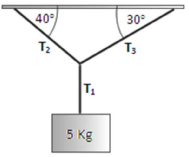1. Find the tension force T1, T2, and T3. Ignore cord’s mass.

Solution

(a) Free-body diagram for object (b) Free-body diagram for cord
Apply the Newton’s first law on the object :
ΣFy = 0
T1 – w = 0
T1 = w = m g
T1 = (5 kg)(9.8 m/s2)
T1 = 49 kg m/s2
T1 = 49 N
Apply Newton’s first law on the cord :
∑Fx = 0
T3x – T 2x = 0
T3 cos 30o – T2 cos 40o = 0
0.87 T3 – 0.77 T2 = 0
0.87 T3 = 0.77 T2
T2 = 0.87 T3 / 0.77 = 1.1 T3 ———- Equation 1
——
∑Fy = 0
T3y + T2y – T1y = 0
T3 sin 30o + T2 sin 40o – T1 = 0
0.5 T3 + 0.64 T2 – 49 N = 0 ———- Equation 2
Substituting T2 in the equation 2 into the equation 2 :
0.5 T3 + 0.64 (1.1 T3) – 49 N = 0
0.5 T3 + 0.70 T3 – 49 = 0
1.2 T3 – 49 = 0
1.2 T3 = 49
T3 = 49 / 1.2
T3 = 41 N
———
T2 = 1.1 T3
T2 = (1.1)(40.8 N)
T2 = 45 N
[wpdm_package id=’488′]
- Particles in one-dimensional equilibrium
- Particles in two-dimensional equilibrium
- Equilibrium of bodies connected by cord and pulley
- Equilibrium of bodies on inclined plane
